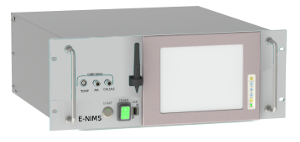
Key Features
- Direct ppb measurement of Airborne Molecular Contaminations (AMC)
- Approved IMS technology
- Non-radioactive ionization by stable electron beam
- No X-ray licensing required
- Fast response and cleardown
- No interference from acid gases and halogens
- Continuous, unattended monitoring
- Optional multipoint sampling
Innovative Technology
The ion mobility spectrometer E-NIMS is an advanced analytical device for fast and reliable trace detection of volatile compounds in industrial environments. E-NIMS combines state-of-the-art ion mobility spectrometry with an innovative non-radioactive ionisation technology. A special tailored electron beam source offering high stability, pulsed mode operation and intensity control allows efficient ionization and outstanding performance. With the E-NIMS, elaborate licensing, regulatory supervision and disposal of radio-active material, as it is neccessaray for most conventional ion mobility devices, belongs to the past. The E-NIMS opens up new areas of applications.
Applications
- Continuous emission monitoring of ammonia (NH3) in ambient air
- Detection range: 0-50 ppb, lower detection limit (LDL): 2 ppb
- Cleanroom air and process monitoring, e.g. in semiconductor industry or optical goods industry
- Determination of further molecular bases (amines, NMP), molecular acids and halogens on request
- Approved IMS-Technology
-
Ion mobility spectrometry (IMS) represents a widely accepted and established analytical technique in many applications.
In ion mobility spectrometry characteristic drift velocities of ionized molecules (cations or anions) in an electrical field at atmospheric pressure are determined. Separation of the ions according to mass and size, followed by their detection at a Faraday cup and amplification of the ion current yields typical IM spectra. From the drift time and intensity of the signals both qualitative and quantitative analytical information are obtained.
With IMS-devices a direct measurement of volatile compounds in ambient air within a few seconds is possible without an elaborate sample preparation, so no reagents or other consumables are required for operation. A very sensitive detection in the ppb to ppt range is achieved. The selectivity of detection depends on the proton or electron affinity of the analytes and may be increased using specific dopant compounds. In our system sampling is realized via a sample loop for continuous sampling with fast response and cleardown. - E-NIMS for airborne molecular contamination (AMC) monitoring
-
Due to the advantages of IMS in general and the specific features of the non-radioactive ionization source E-Ray, E-NIMS
is ideally suited for a sensitive and continuous on-line detection of volatile industrial compounds in industrial environments.
E-NIMS is especially designed for the detection of airborne molecular contamination (AMC) e.g. in semiconuctor industries, and optimized for the detection of specific substances. E-NIMS-NH3 is adapted for ammonia quantification, it provides a detection limit of 2 ppb and a detection range up to 50 ppb.
On request, further molecular bases (amines, NMP), molecular acids and halogens can be determined.
- Electron beam source for ionization
-
The E-NIMS employs a novel and innovative non-radioactive ionization source for IMS called E-Ray.
A cathod ray tube delivers electrons with an energy of 12 keV, which pass out through a thin but stable and inert ceramic membrane. The electrons are scattered and stopped in the atmosphere forming a small and well defined spherical ionization volume of approx. 1 mm diameter.
The emitted electrons have a kinetic energy com-parable to the electron energy of b-sources (3H, 63Ni) common in conventional IMS. So the E-Ray source leads to the same well-understood ionization mechanisms and offers following further improved analytical features.
The E-Ray generates a high electron current (max. 10 µA), which exceeds the intensity of typical b-sources (100 Mbq ~ 60 pA) by several orders of magnitude. As result an outstanding sensitivity of the E-NIMS is obtained. Moreover the intensity of the electron source can be adjusted leading to an enhanced dynamic range.
The source is not subject to any degradation processes, so it provides a stability which is comparable to common radioactive sources and unique for non-radioactive sources. Thus a high repeatablity of the analytical results is achieved.
- Sampling, detection & calibration
-
Gas samples are taken from a port at the rear side by an internal pump via a sample loop. Sampling tubes (recommended PFA or
PTFE, max. length = 50m) are connected directly or via an optional multiplexer to the sample port using standard 6 mm connectors.
Due to the sample loop, memory effects are minimized. The sampling occurs once a minute. Within 15 s IMS data are aquired with 5 Hz using an ultra-low noise current amplifier. The analyte concentration is calculated from this complete dataset. This allows a continuous monitoring with a one-minute temporal resolution and a high reliability.
The device is operated at elevated temperature, fast response and cleardown times as well as a short start-up time (60 min) are obtained even for analytes like ammonia.
Ammonia and other AMC are ionized via continuously added and primary ionized dopant molecules. Dopant and analyte signals are completely separated and the influence of varying environmental conditions is minimized. E-NIMS is equipped with an internal calibration. The software includes a calibration routine offering a simple and fast two point calibration of the device using an internal standard.